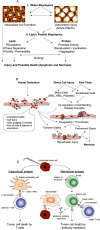Adjuvant approaches to enhance cryosurgery
- PMID: 19640135
- PMCID: PMC4934372
- DOI: 10.1115/1.3156804
Adjuvant approaches to enhance cryosurgery
Abstract
Molecular adjuvants can be used to enhance the natural destructive mechanisms of freezing within tissue. This review discusses their use in the growing field of combinatorial or adjuvant enhanced cryosurgery for a variety of disease conditions. Two important motivations for adjuvant use are: (1) increased control of the local disease in the area of freezing (i.e., reduced local recurrence of disease) and (2) reduced complications due to over-freezing into adjacent tissues (i.e., reduced normal functional tissue destruction near the treatment site). This review starts with a brief overview of cryosurgical technology including probes and cryogens and major mechanisms of cellular, vascular injury and possible immunological effects due to freeze-thaw treatment in vivo. The review then focuses on adjuvants to each of these mechanisms that make the tissue more sensitive to freeze-thaw injury. Four broad classes of adjuvants are discussed including: thermophysical agents (eutectic forming salts and amino acids), chemotherapuetics, vascular agents and immunomodulators. The key issues of selection, timing, dose and delivery of these adjuvants are then elaborated. Finally, work with a particularly promising vascular adjuvant, TNF-alpha, that shows the ability to destroy all cancer within a cryosurgical iceball is highlighted.
Figures



References
-
- Hoffmann NE, Bischof JC. The cryobiology of cryosurgical injury. Urology. 2002;60(2 Suppl 1):40–9. - PubMed
-
- Kuflik EG. Re: Evidence-based review of the use of cryosurgery in treatment of basal cell carcinoma. Dermatol Surg. 2004;30(3):478. - PubMed
-
- Cooper IS. Cryobiology as Viewed by the Surgeon. Cryobiology. 1964;51:44–51. - PubMed
-
- Cooper IS. Cryogenic Surgery for Cancer. Fed Proc. 1965;24:S237–40. - PubMed
-
- Cooper IS, Stellar S. Cryogenic Freezing of Brain Tumors for Excision or Destruction in Situ. J Neurosurg. 1963;20:921–30. - PubMed
Publication types
MeSH terms
Substances
Grants and funding
LinkOut - more resources
Full Text Sources
Other Literature Sources

